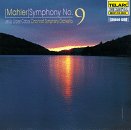| All Artists: Gustav Mahler, Jesús López-Cobos, Cincinnati Symphony Orchestra Title: Mahler: Symphony No. 9 Members Wishing: 0 Total Copies: 0 Label: Telarc Release Date: 1/28/1997 Genre: Classical Style: Symphonies Number of Discs: 2 SwapaCD Credits: 2 UPC: 089408042621 |
Search - Gustav Mahler, Jesús López-Cobos, Cincinnati Symphony Orchestra :: Mahler: Symphony No. 9
 | Gustav Mahler, Jesús López-Cobos, Cincinnati Symphony Orchestra Mahler: Symphony No. 9 Genre: Classical
|
Larger Image |
CD DetailsSimilar CDs |
CD ReviewsAudiophile quality indeed! Larry VanDeSande | Mason, Michigan United States | 03/16/2004 (5 out of 5 stars) "When reviewing this performance, American Record Guide called it the best-sounding Mahler symphony. That title may have been eclipsed by the new Kaplan Mahler Symphony 2 on DG, but this one is still the best sounding Mahler 9 out there. The very German-sounding Cincinnati Symphony Orchestra outdoes most of its international competitors in this work with playing and eloquence that has crystalline clarity and extraordinary depth of tone. No section of this orchestra -- brass, strings, woodwinds or timpani -- takes a back seat to another. The interpretation is not so out of the ordinary, although no one would righly say Lopez Cobos doesn't understand the music. He seeks not to present it with the sense of occasion of Walter, the profundity of Karajan, the angst of Bernstein, or the quirkiness of Horenstein. For me that is not a negative. I don't ask to hear Bernstein when I listen to Mahler; I ask to hear Mahler. Almost 100 years after his death, with no friends left to discuss him, his notes are the easiest way to his message. This is what Lopez Cobos has done in one of the best sounding CDs extant." Well Caressed D. Seymour | Atlanta, GA USA | 05/26/2002 (5 out of 5 stars) "The advantage that this recording of Mahler's 9th Symphony has over any other is the spectacular Telarc Sound. It is deep and spacious and amazingly present. Just listen to the first three minutes when the brass blaze out of the early morning dawn laid out by the strings. In the 1st movement, the Cincinnati Symphony weaves a fine tapestry between the brass and the strings. You can almost hear the mountains echoing back from the delicate 2nd movement Landler. Lopez-Cobos takes the Rondo-Burleske at a turbulent but muted clip. The peaceful Adagio that closes the symphony clocks in at almost 28 minutes, squeezing out every last ounce of sorrow from the score. Lopez-Cobos takes a romantic approach to this dissonant and somewhat disparate symphony. Most of Mahler's hard edges have been polished off for this performance. So, if you like your Mahler clean and respectable, get this recording. If you prefer Mahler with some dirt under the fingernails, go for the Boulez. Both are excellent." The Ultimate Mahler recording Erick Matta | Texas, USA | 01/05/2006 (5 out of 5 stars) "simply put, you just can't do any better than this! the playing is beyond reproach not only from a technical view point, but musically as well(fearless elegance). lopez-cobos comes through with what i feel is an interpretation of great musical conviction, without losing a great sense of structure and clarity.. a wonderful balance of well thought out egoless musical ideas on his part.
and as others have mentioned, the sound quality is to die for! no other orchestral recording has ever come this close to recreating the experience of listening to an orchestra in person. as an audiophile, i own many fine recordings from the likes of Dorian, Refernece, Lyrita, Delos, Conifer, Harmonia Mundi, and even Telarc themselves, but nothing sounds as close to the real thing as this... transparency in spades, explosive dynamics, soundstaging, and imaging! this has been the single most listened to disc in my library of over 2300 discs for the past 5 years. don't even think about it just buy it NOW!" |

 Track Listings (2) - Disc #1
Track Listings (2) - Disc #1
